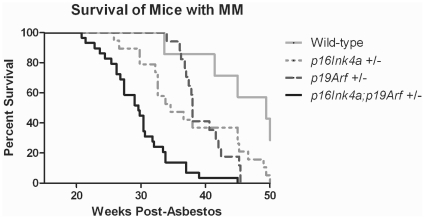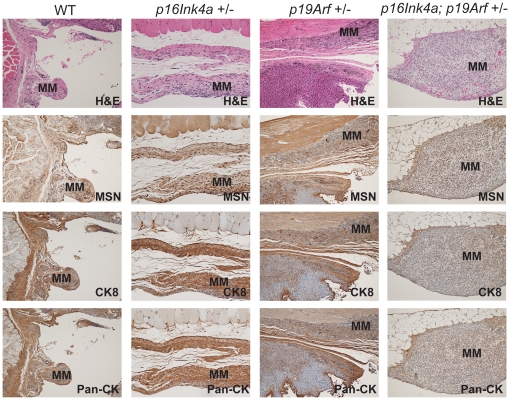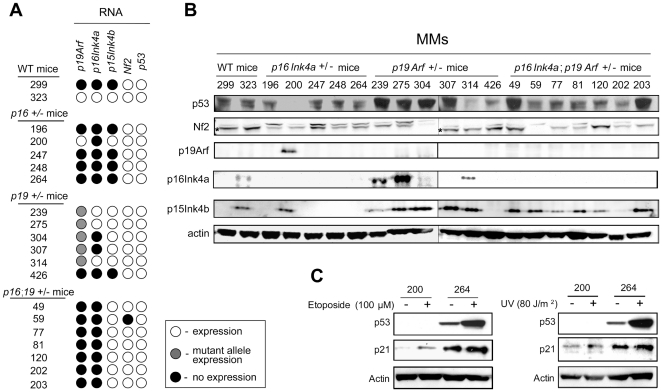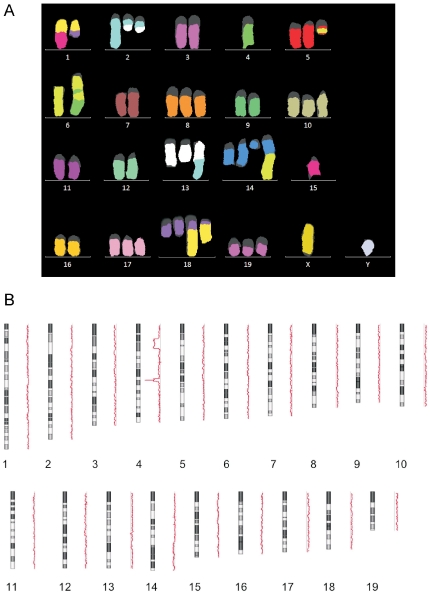Abstract
The CDKN2A/ARF locus encompasses overlapping tumor suppressor genes p16(INK4A) and p14(ARF), which are frequently co-deleted in human malignant mesothelioma (MM). The importance of p16(INK4A) loss in human cancer is well established, but the relative significance of p14(ARF) loss has been debated. The tumor predisposition of mice singly deficient for either Ink4a or Arf, due to targeting of exons 1α or 1β, respectively, supports the idea that both play significant and nonredundant roles in suppressing spontaneous tumors. To further test this notion, we exposed Ink4a(+/−) and Arf(+/−) mice to asbestos, the major cause of MM. Asbestos-treated Ink4a(+/−) and Arf(+/−) mice showed increased incidence and shorter latency of MM relative to wild-type littermates. MMs from Ink4a(+/−) mice exhibited biallelic inactivation of Ink4a, loss of Arf or p53 expression and frequent loss of p15(Ink4b). In contrast, MMs from Arf(+/−) mice exhibited loss of Arf expression, but did not require loss of Ink4a or Ink4b. Mice doubly deficient for Ink4a and Arf, due to deletion of Cdkn2a/Arf exon 2, showed accelerated asbestos-induced MM formation relative to mice deficient for Ink4a or Arf alone, and MMs exhibited biallelic loss of both tumor suppressor genes. The tumor suppressor function of Arf in MM was p53-independent, since MMs with loss of Arf retained functional p53. Collectively, these in vivo data indicate that both CDKN2A/ARF gene products suppress asbestos carcinogenicity. Furthermore, while inactivation of Arf appears to be crucial for MM pathogenesis, the inactivation of both p16(Ink4a) and p19(Arf) cooperate to accelerate asbestos-induced tumorigenesis.
Introduction
CDKN2A/ARF is among the most commonly mutated loci in human cancer, encoding two different tumor suppressors translated from alternatively spliced mRNAs. p16(INK4A) is composed of exons 1α, 2 and 3, and is designated here as INK4A (inhibitor of cyclin dependent kinase 4). Human p14(ARF) is encoded by exon 1β and alternate reading frames of CDKN2A/ARF exons 2 and 3, herein referred to as ARF (alternate reading frame). Knockout mice with targeted deletion of specific Cdkn2A/Arf exons have disrupted p16Ink4a, p19Arf or both genes [1], [2], [3], [4] and develop a different spectrum of spontaneous tumors, although not malignant mesotheliomas (MMs). A differential impact of heterozygous loss of Ink4a or Arf to the induction of MM by asbestos has not been previously addressed. The studies presented here provide genetic evidence for the significance of Ink4a and Arf alterations in MM by directly comparing susceptibility to tumor induction by asbestos in Ink4a-deficient, Arf-deficient and doubly heterozygous Ink4a;Arf mice in a common genetic background. The enhanced tumor susceptibility of mice singly deficient for either p16(Ink4a) or p19(Arf) supports the view that both play significant and nonredundant roles in suppressing malignant transformation. The fact that mice deficient for both tumor suppressors have accelerated tumor development indicates that inactivation of both p16(Ink4a) and p19(Arf) cooperate to promote asbestos carcinogenicity.
Results
Using a genetic approach, we assessed the relative contribution of Ink4a and Arf deficiency to induction of asbestos-induced tumor formation. MM incidence was increased and latency decreased in Ink4a(+/−) and Arf(+/−) mice relative to wild-type littermates (Fig. 1, Supporting File S1). Mice doubly deficient for Ink4a;Arf had accelerated asbestos-induced MMs relative to mice deficient for Ink4a or Arf alone. As in prior studies [5], [6], [7], MM did not develop in TiO2-treated mice (Supporting File S1). Median latency for MM detection after initial asbestos exposure was 29.6 weeks for Ink4a;Arf(+/−), 34.6 weeks for Ink4a(+/−), 38.0 weeks for Arf(+/−), and 49.4 weeks for wild-type mice. Ink4a-, Arf- and Ink4a;Arf-deficient mice had decreased survival compared to wild-type mice (Fig. 1). Tumor latency for Ink4a- and Arf-deficient mice was not significantly different, whereas latency was decreased in Ink4a;Arf-deficient mice (p<0.0001).
Figure 1. Accelerated asbestos-induced MM in mice deficient for Ink4a, Arf, or Ink4a;Arf.
Kaplan-Meier survival curves (GraphPad Prism 5). Mice with no tumors or with incidental tumors were censored. A log-rank test verified significant differences between wild-type and Ink4a-, Arf- and Ink4a;Arf-deficient groups (p-value = 0.0342, 0.0312, and <0.0001, respectively).
Sarcomatoid MMs were prevalent in all asbestos-treated mice (Fig. 2), although biphasic and epithelial morphology were occasionally observed. MMs frequently presented with ascites, occasional spheroids, and diffuse peritoneal seeding of the serosal lining. Most tumors in wild-type mice were early-stage MMs, whereas tumors in Ink4a(+/−), Arf(+/−), and Ink4a;Arf(+/−) mice generally were more advanced. Extensive disease was most evident in doubly heterozygous mice. In a few cases, diagnosis was difficult because MMs may arise anywhere in the abdominal cavity and may not be obvious in the sampled tissues. Thus, where possible, tumor cells from ascites or peritoneal lavage were tested with markers to verify MM (Supporting File S1).
Figure 2. Representative histopathology of asbestos-induced MMs.
Sections were stained with hematoxylin and eosin (H&E) or with antibodies against mesothelin (MSN), cytokeratin (CK8), and pan-cytokeratin (Pan-CK).
Using early passage (≤6) MM cells, we found biallelic infactivation of the predisposing tumor suppressor gene in all MMs tested (Fig. 3A). In most (4 of 5 tested) MMs from Ink4a(+/−) mice, there also was loss of Arf and p15(Ink4b), the latter located near the Cdkn2a/Arf locus. Tumor #200, from an Ink4a(+/−) mouse, retained expression of Arf but did not express p53 protein. Interestingly, in MM cells with loss of Arf, the p53 pathway appeared to remain functional intact based on their response to DNA damage with etoposide (100 µM) or UV irradiation (80 J/m2) (Fig. 3C).
Figure 3. Biallelic inactivation of predisposing Ink4a and Arf tumor suppressor genes in MM.
A, Composite depicting RT-PCR for Arf exon 1β, Ink4a exon 1α, Ink4b, Nf2 and Tp53 from primary MM cells (passage ≤5). B, Immunoblotting of MM cells. Note that Arf was lost in nearly all tumors, with p53 expression being absent in the only tumor (#200) retaining Arf expression. Two bands were observed in the Nf2 immunoblot (panel 3). An asterisk beside the lower band depicts Nf2, with a non-specific band accounting for the upper signal. Actin was a loading control. C, Immunoblot of MM cells treated with Etoposide (100 µM) or UV irradiation (80 J/m2) 24 hours post-treatment.
MMs from Arf(+/−) mice consistently exhibited loss of Arf protein. In 4 of 5 samples tested, the mutant Arf allele was retained, as determined by RT-PCR (Supplemental Fig. S2); insertion of the neo-selectable marker used in the Arf targeting strategy results in a stop codon and no Arf protein expression (Fig. 3). Arf(+/−) mice showed loss of Ink4a expression in 3 of 6 MM cultures, whereas p15(Ink4b) was retained in 5 of 6 cultures (Fig. 3). Similarly, inactivation of Ink4a and p15(Ink4b) were not required for MM formation in a C57Bl/6 Arf(+/−) model [6].
MMs from Ink4a;Arf doubly heterozygous mice exhibited biallelic inactivation of Ink4a and Arf, whereas Ink4b was retained in 6 of 7 MM samples tested. Expression of Nf2 and p53 was retained in nearly all MM cultures from Ink4a(+/−), Arf(+/−), and Ink4a;Arf(+/−) mice (Fig. 3).
Cytogenetic analyses were performed on two randomly-selected MM cultures from each mouse model. As in the human disease counterpart, MMs from Ink4a-, Arf-, and Ink4a;Arf-deficient mice typically showed numerous chromosome alterations. No consistent alteration was seen, although 3 of 6 tumors had extra copies of chromosome 19, including a MM from an Ink4a(+/−) mouse (#264), in which gain of chromosome 19 was the only abnormality observed. MM cultures from Arf- and Ink4a;Arf-deficient mice typically had numerous clonal structural rearrangements (Fig. 4A). Furthermore, aCGH analysis revealed a homozygous deletion encompassing the Cdkn2a/Arf locus (Fig. 4B).
Figure 4. Chromosomal analyses of MM cells from an Arf-deficient mouse.
A, mFISH revealed one or more copies of 1;15, 1;18, 2;13, 5;6, and 6;14 rearrangements; der(6) composed of (from centromere to telomere) segments of chromosomes 6, 4, 6, and 4; deletion of chromosome 14; and trisomies of chromosomes 8, 10, 17 and 19. B, aCGH analysis showed gains of chromosomes 8, 10, 13, 17, 18, and 19; and deletions of two regions of chromosome 4, one of which (lower) represents a homozygous deletion encompassing the Cdkn2a/Arf locus embedded within a hemizygous deletion.
Discussion
Previous studies have shown that Arf(−/−) and Ink4a(−/−) mice are more prone to spontaneous tumors than wild-type animals, but each less so than Ink4a;Arf(−/−) mice [8]. The in vivo carcinogenesis studies reported here evaluated the contribution of heterozygous mutations of Arf and Ink4a, as well as a both tumor suppressor genes, to the induction of MM by asbestos, a well-established cause of this malignancy. In vivo genetic models were used to investigate the relative impact of Arf versus Ink4a deficiency in a common genetic background. By analogy, our findings suggest that p14(ARF), like p16(INK4A), is an important target of 9p21 deletions in human MM. Moreover, the data indicate that co-deletion of Arf and Ink4a can cooperate to accelerate tumorigenesis.
In previous studies of heterozygous Arf mice, spontaneous tumors exhibited loss of the residual wild-type Arf allele [2], consistent with a classical two-hit tumor suppressor gene. We found asbestos-induced MMs from heterozygous Ink4a, Arf and Ink4a;Arf mice required biallelic inactivation of the predisposing tumor suppressor genes, and MMs were detected faster in the doubly deficient model. The importance of these tumor suppressors is in accordance with an investigation using conditional knockout mice [9], in which adeno-Cre-mediated homozygous excision of Ink4a;Arf was sufficient to induce MM in the absence of asbestos exposure.
Notably, while tumor cells from Ink4a(+/−)-deficient mice acquired loss of Arf or p53 expression, loss of p16(Ink4a) was observed in only 3 of 6 MMs from Arf(+/−) mice. Similarly, in our earlier studies of Arf-deficient mice in a different (C57Bl/6) genetic background, all 11 MMs analyzed showed loss of Arf, although loss of p16(Ink4a) was identified in only two tumors. Collectively, these data imply that inactivation of Arf or p53 may be crucial for MM pathogenesis, whereas inactivation of p16(Ink4a) is not.
Since MMs analyzed here retained expression of p15Ink4b, loss of this gene is not critical for induction of MM by asbestos. In addition, our deletion mapping studies of human MMs revealed that deletions of p15INK4B occur less frequently than losses of CDKN2A/ARF and never occurred in the absence of a homozygous loss in the CDKN2A/ARF locus [5].
Also similar to our earlier study of Arf-deficient mice in a different (C57Bl/6) background, we rarely observed loss of Nf2 in MMs arising in Ink4a-, Arf- or Ink4a;Arf-deficient mice. Inactivation of the NF2 tumor suppressor gene is postulated to facilitate cell cycle progression and tissue invasion/metastasis [10], and Nf2-deficient mice are predisposed to asbestos-induced MM and contribute to its invasiveness and spreading [5], [11]. However, NF2/merlin loss does not appear to be required for development of MM in mice having this genotype and/or background.
Lastly, we found retention of functional p53 expression in MM cells that exhibit loss of Arf expression. Only one of the 20 asbestos-induced MMs showed loss of p53 expression (Fig. 3B), and that single sample retained expression of Arf, consistent with our previous work showing a reciprocal pattern of inactivation of Tp53 in asbestos-induced MMs from Nf2(+/−) mice that had retained expression of Arf [5], [6]. Interestingly, in MM cells with loss of Arf, the p53 pathway appeared to remain functional based on response to DNA damage (Fig. 3C). These results from genetic model systems suggest that Arf loss can contribute to MM pathogenesis via p53-independent pathway(s), as previously noted in human MM cells [12], and that an intact p53 pathway remains a potential target for the treatment of this highly aggressive, chemo-resistant malignancy.
In summary, this is the first report directly assessing the relative importance of Ink4a and Arf in the susceptibility to asbestos-induced MM. Collectively, these in vivo data indicate that both Cdkn2A/Arf gene products suppress asbestos carcinogenicity. Furthermore, while Arf inactivation appears to be critical for MM pathogenesis and genomic instability (Fig. 4), the inactivation of both p16(Ink4a) and p19(Arf) cooperate to accelerate asbestos-induced tumorigenesis. Thus, future therapeutic approaches for MM should consider targeting pathways cooperatively regulated by both tumor suppressor genes.
Materials and Methods
Animals and treatments
Ink4a (01XE4, FVB.129-Cdkn2atm2.1Rdp) [3] and Ink4a;Arf (01XB2, FVB/N.129-Cdkn2atm1Rdp) [4] mice were from the Mouse Models of Human Cancers Consortium. Mice lacking Arf (a gift of N. Sharpless) were generated with Cre-mediated excision of the neomycin selection cassette, similar to Ink4a mice [3]. All mice were in a comparable genetic background [8]. Mice were backcrossed at least two additional generations with FVB/N mice for uniformity and genotyped as described (MMHCC and [8]). Procedures were compliant with the NIH Guide for the Care and Use of Laboratory Animals.
6–8 week-old mice were injected intraperitoneally every 3 weeks with 400 µg crocidolite (UICC, SPI Supplies) (total, 3.2 mg/mouse), or with equivalent control TiO2 particles (Aldrich) [5], [6]. Mice were scored as having MM based on histological evidence and/or if tumor cells exhibited a combination of three or more MM markers, including mesothelin, as assessed by reverse transcriptase-PCR (RT-PCR) and/or immunohistochemistry (Supplemental tables in File S1, Supplemental Fig. S1). This study was carried out in strict accordance with the recommendations in the Guide for the Care and Use of Laboratory Animals of the National Institutes of Health. The protocol was approved by the Committee on the Ethics of Animal Experiments of the Fox Chase Cancer Center (protocol number: 00-26). All surgery was performed under sodium pentobarbital anesthesia, and all efforts were made to minimize suffering.
Immunohistochemistry
Slides of formalin-fixed, paraffin-embedded samples were incubated with antibodies against pan-cytokeratin and cytokeratin 8 (Sigma) and mesothelin (Santa Cruz Biotechnology), which were detected with biotinylated secondary antibodies. Sections were stained with DAB and counterstained with hematoxylin.
Primary cell cultures
Primary MM cells were isolated from ascitic fluid and/or peritoneal lavage, as described [5]. All primary cell cultures used for the molecular analyses were from passages ≤6. PCR analysis was conducted on all cultures that expressed mesothelial markers, and immunoblot analysis was performed on a random set of cultures to validate the PCR results. To test for p53, sub-confluent mouse MM cells (>passage 6) were treated with Etoposide (100 µM) or UV irradiation (80 J/m2) and harvested 24 hours post-treatment for immunoblotting.
PCR
RT-PCR was used to evaluate tumor cells for expression of E-cadherin, N-cadherin, cytokeratin 18 and cytokeratin 19 [5]. Control Gapdh was used to assess template integrity [6]. RT-PCR for mesothelin used primers 5′-ATCAAGACATTCCTGGGTGGG-3′ and 5′-CGGTTAAAGCTGGGAGCAGAG-3′. Oligonucleotides for genomic and RT-PCR of Ink4a, Ink4b, Nf2 and p53 were as described [5], [6]. Primers for p19(Arf) exon 1β were based on National Center of Biotechnology Information (NCBI) sequences.
Immunoblotting
Immunoblots were prepared with 15–30 µg of protein/sample, as described [5], [6]. Antibodies included anti-Arf (Abcam), anti-p53 (NCL-p53-505, Novocastra), and anti-Ink4a (M-156), -Nf2 (H-260), and -β-actin (I-19) (Santa Cruz).
Karyotypic and M-FISH Analysis
Preparation of metaphases and G-banding were performed as reported [13]. Guidelines for karyotypic designations of mouse metaphase chromosomes are found at http://www.pathology.washington.edu/research/cytopages/idiograms/mouse/. Metaphase preparations were hybridized using a 21Xmouse mFISH kit (MetaSystems). Image capturing/processing utilized a Zeiss AxioImager Z2 fluorescence microscope, with single band pass filters (Chroma Technology) appropriate for each fluorochrome and an Isis/mFISH image analysis system (MetaSystems).
Array-CGH
Genomic DNA was isolated from primary MM cell cultures at passages ≤6. Agilent 244K Genomic DNA Arrays and scanner were used for DNA copy number analysis. Data were extracted using Feature Extraction Software, and output was imported into CGH Analytics for DNA Copy Number Analysis (Agilent).
Supporting Information
Immunohistochemical staining of a MM tumor with anti-mesothelin (MSN) or anti-MSN plus blocking peptide to show specificity of staining.
(TIF)
Retention of mutant Arf allele in MMs from Arf (+/−) mice. A, Abnormally large RT-PCR product amplified with Arf-specific primers for exon 1β. Samples are from MM cells of five Arf (+/−) mice (lanes 1–5); lane 6 is from wild-type mouse embryonic fibroblasts. B, Sequencing of PCR products revealed an 84-bp insertion (grey italicized letters) in the mutated Arf allele (Mu.) replacing an AG (underlined) in the wild-type allele (Wt.). The insertion generates a predicted stop codon (marked in black), which would result in unsuccessful translation of the p19(Arf) protein.
(TIF)
MM Markers for primary cell cultures derived from asbestos-treated mice.
(DOC)
Acknowledgments
The following Fox Chase Cancer Center shared facilities were used: Laboratory Animal, Biostatistics, Biotechnology, Cell Culture, and Genomics.
Footnotes
Competing Interests: One of the authors (I.C.) is employed by a commercial company (MetaSystems, Altlussheim, Germany). This fact does not alter the authors' adherence to all the PLoS ONE policies on sharing data and materials. The remaining authors declare that no competing interests exist.
Funding: This research was supported by grants from the National Cancer Institute (P01CA114047 to J.R.T., M.C., CA06927 to J.R.T., A.J.K.-S.), and CA009035 (C.W.M.), by the Commonwealth of Pennsylvania (Fox Chase Cancer Center), and by the Local No. 14 Mesothelioma Fund of the International Association of Heat and Frost Insulators & Allied Workers (J.R.T.). The funders had no role in study design, data collection and analysis, decision to publish, or preparation of the manuscript.
References
- 1.Kamijo T, Zindy F, Roussel MF, Quelle DE, Downing JR, et al. Tumor suppression at the mouse INK4a locus mediated by the alternative reading frame product p19ARF. Cell. 1997;91:649–659. doi: 10.1016/s0092-8674(00)80452-3. [DOI] [PubMed] [Google Scholar]
- 2.Kamijo T, Bodner S, van de Kamp E, Randle DH, Sherr CJ. Tumor spectrum in ARF-deficient mice. Cancer Res. 1999;59:2217–2222. [PubMed] [Google Scholar]
- 3.Sharpless NE, Bardeesy N, Lee KH, Carrasco D, Castrillon DH, et al. Loss of p16Ink4a with retention of p19Arf predisposes mice to tumorigenesis. Nature. 2001;413:86–91. doi: 10.1038/35092592. [DOI] [PubMed] [Google Scholar]
- 4.Serrano M, Lee H-W, Chin L, Cordon-Cardo C, Beach D, et al. Role of the INK4a locus in tumor suppression and cell mortality. Cell. 1996;85:27–37. doi: 10.1016/s0092-8674(00)81079-x. [DOI] [PubMed] [Google Scholar]
- 5.Altomare DA, Vaslet CA, Skele KL, De Rienzo A, Devarajan K, et al. A mouse model recapitulating molecular features of human mesothelioma. Cancer Res. 2005;65:8090–8095. doi: 10.1158/0008-5472.CAN-05-2312. [DOI] [PubMed] [Google Scholar]
- 6.Altomare DA, Menges CW, Pei J, Zhang L, Skele-Stump KL, et al. Activated TNF-alpha/NF-kappaB signaling via down-regulation of Fas-associated factor 1 in asbestos-induced mesotheliomas from Arf knockout mice. Proc Natl Acad Sci U S A. 2009;106:3430–3435. doi: 10.1073/pnas.0808816106. [DOI] [PMC free article] [PubMed] [Google Scholar]
- 7.Heintz NH, Janssen-Heininger YM, Mossman BT. Asbestos, lung cancers, and mesotheliomas: from molecular approaches to targeting tumor survival pathways. Am J Respir Cell Mol Biol. 2010;42:133–139. doi: 10.1165/rcmb.2009-0206TR. [DOI] [PMC free article] [PubMed] [Google Scholar]
- 8.Sharpless NE, Ramsey MR, Balasubramanian P, Castrillon DH, DePinho RA. The differential impact of p16(INK4a) or p19(ARF) deficiency on cell growth and tumorigenesis. Oncogene. 2004;23:379–385. doi: 10.1038/sj.onc.1207074. [DOI] [PubMed] [Google Scholar]
- 9.Jongsma J, van Montfort E, Vooijs M, Zevenhoven J, Krimpenfort P, et al. A conditional mouse model for malignant mesothelioma. Cancer Cell. 2008;12:261–271. doi: 10.1016/j.ccr.2008.01.030. [DOI] [PubMed] [Google Scholar]
- 10.Poulikakos PI, Xiao GH, Gallagher R, Jablonski S, Jhanwar SC, et al. Re-expression of the tumor suppressor NF2/merlin inhibits invasiveness in mesothelioma cells and negatively regulates FAK. Oncogene. 2006;25 doi: 10.1038/sj.onc.1209587. [DOI] [PubMed] [Google Scholar]
- 11.Fleury-Feith J, Lecomte C, Renier A, Matrat M, Kheuang L, et al. Hemizygosity of Nf2 is associated with increased susceptibility to asbestos-induced peritoneal tumours. Oncogene. 2003;22:3799–3805. doi: 10.1038/sj.onc.1206593. [DOI] [PubMed] [Google Scholar]
- 12.Hopkins-Donaldson S, Belyanskaya LL, Simões-Wüst AP, Sigrist B, Kurtz S, et al. p53-induced apoptosis occurs in the absence of p14(ARF) in malignant pleural mesothelioma. Neoplasia. 2006;8:551–559. doi: 10.1593/neo.06148. [DOI] [PMC free article] [PubMed] [Google Scholar]
- 13.Testa JRGL, Salazar H, Liu Z, Handel LM, Godwin AK, Hamilton TC. Spontaneous transformation of rat ovarian surface epithelial cells results in well to poorly differentiated tumors with a parallel range of cytogenetic complexity. Cancer Res. 1994;54:2778–2784. [PubMed] [Google Scholar]
Associated Data
This section collects any data citations, data availability statements, or supplementary materials included in this article.
Supplementary Materials
Immunohistochemical staining of a MM tumor with anti-mesothelin (MSN) or anti-MSN plus blocking peptide to show specificity of staining.
(TIF)
Retention of mutant Arf allele in MMs from Arf (+/−) mice. A, Abnormally large RT-PCR product amplified with Arf-specific primers for exon 1β. Samples are from MM cells of five Arf (+/−) mice (lanes 1–5); lane 6 is from wild-type mouse embryonic fibroblasts. B, Sequencing of PCR products revealed an 84-bp insertion (grey italicized letters) in the mutated Arf allele (Mu.) replacing an AG (underlined) in the wild-type allele (Wt.). The insertion generates a predicted stop codon (marked in black), which would result in unsuccessful translation of the p19(Arf) protein.
(TIF)
MM Markers for primary cell cultures derived from asbestos-treated mice.
(DOC)






